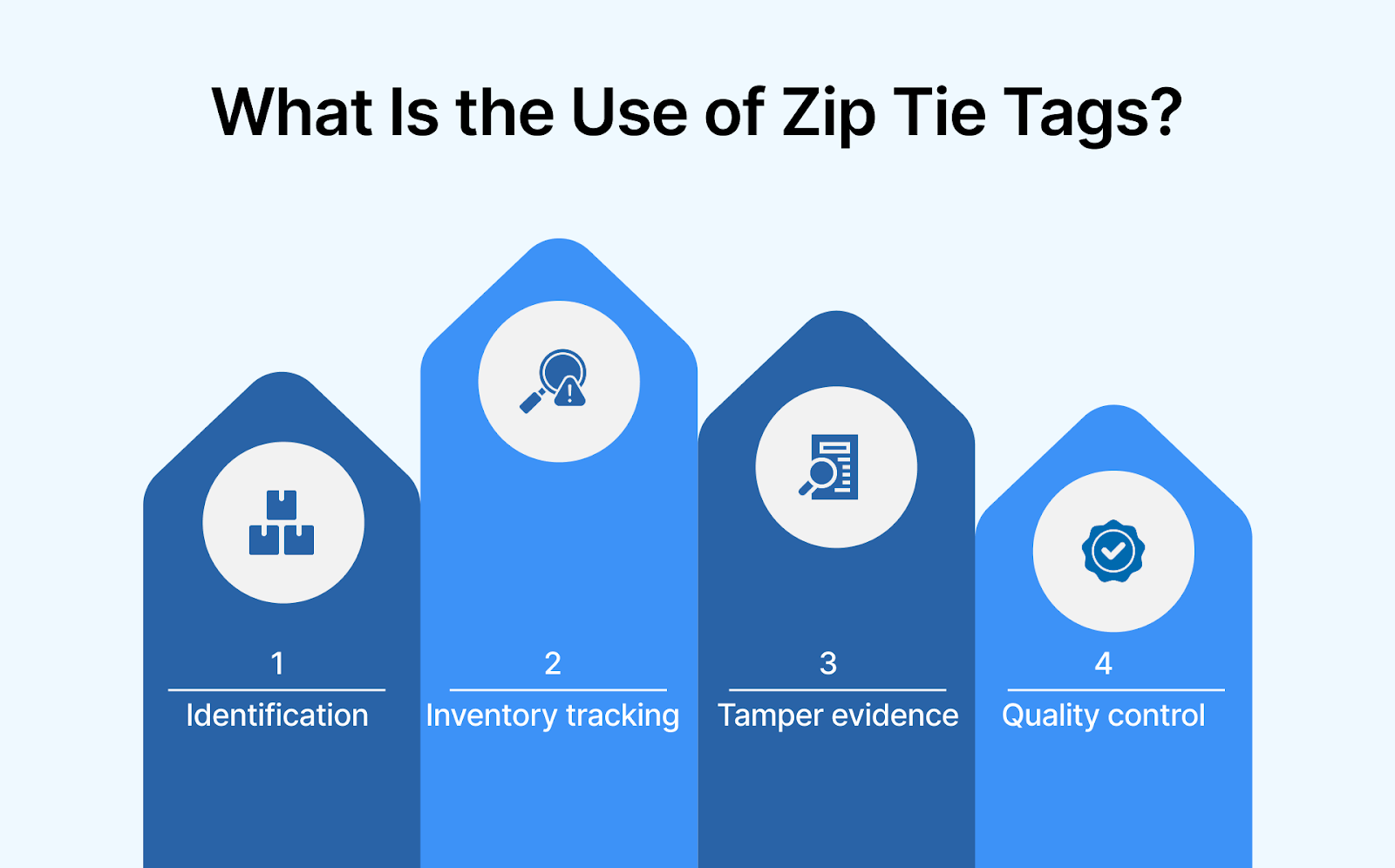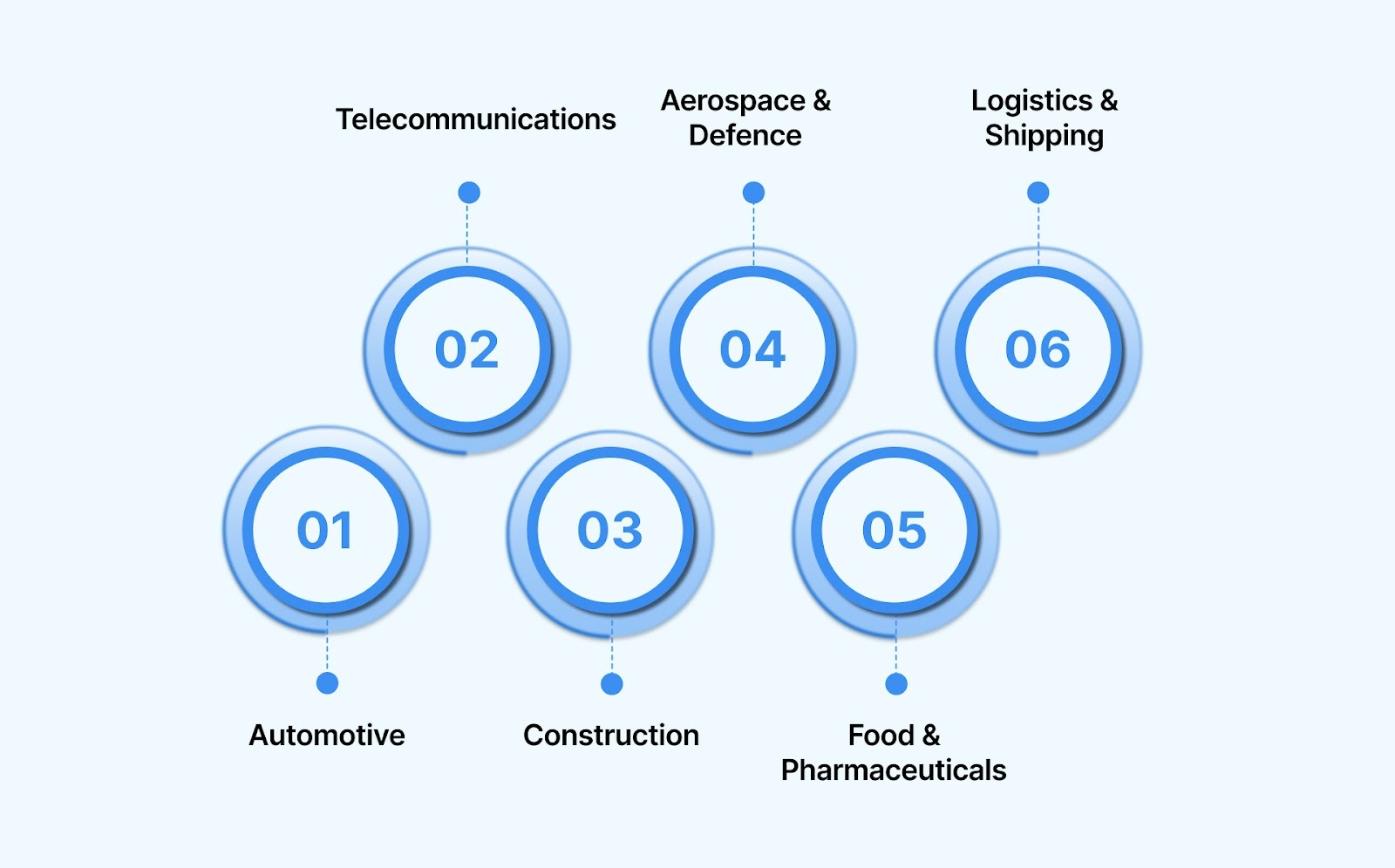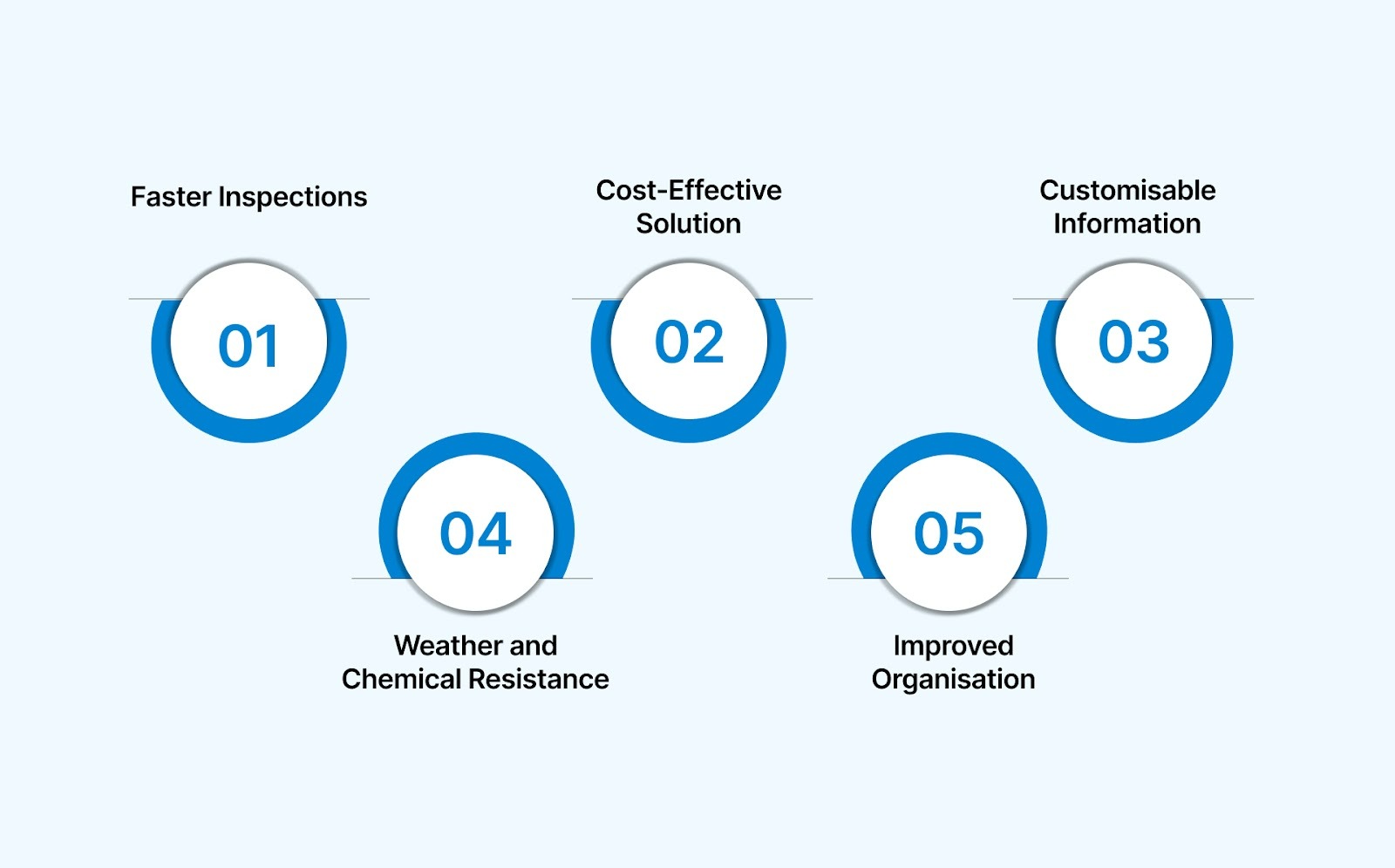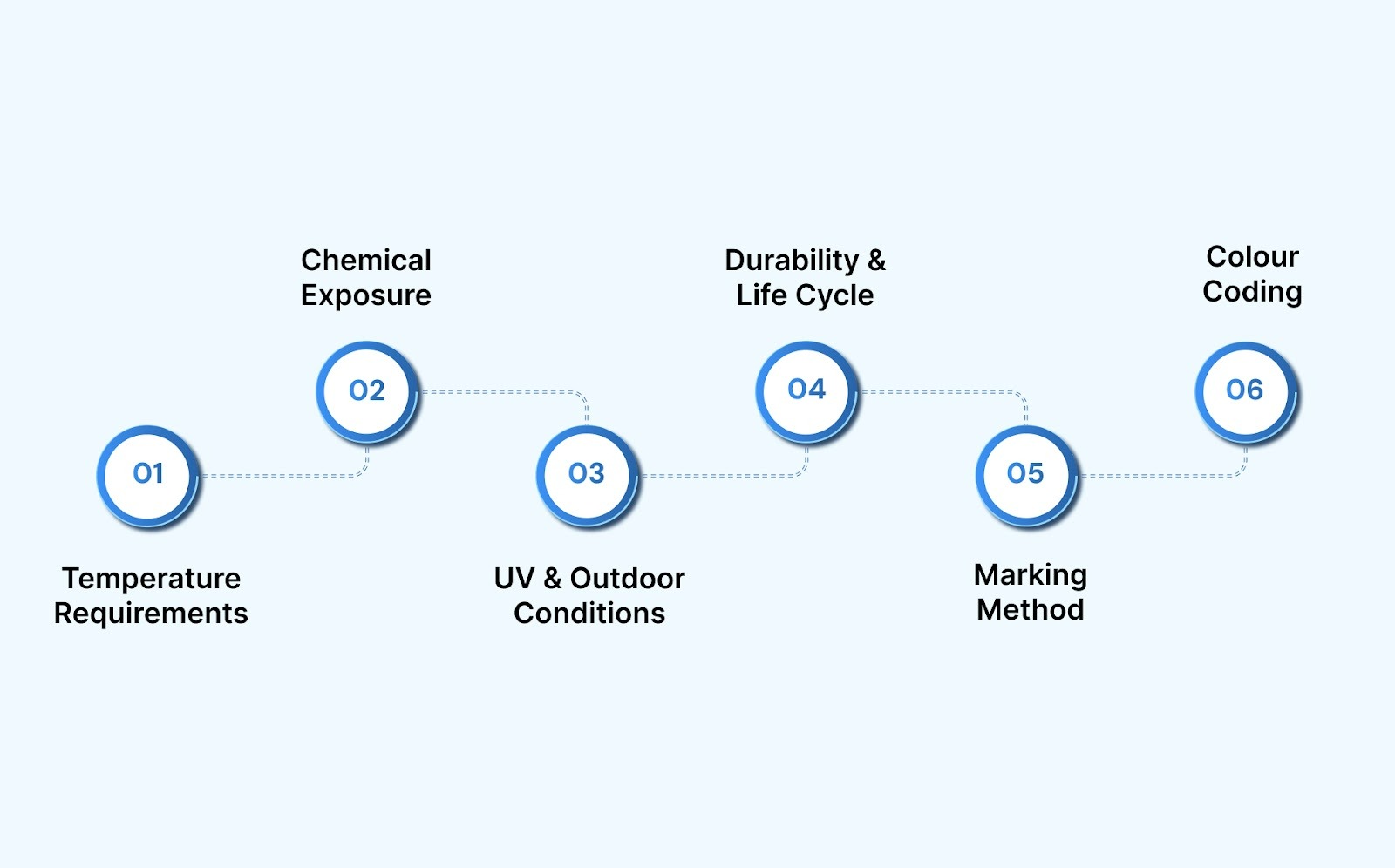What Are Zip Tie Tags Used For: Identification and Security
October 24, 2025

Cables that are left unmarked create risks. They slow down troubleshooting, extend service interruptions, and expose teams to costly errors during installation or repair.
For procurement and operations leaders, the impact is bigger than delays. Misidentified wiring can cause compliance failures, increase accident risk, and add unnecessary expense during audits and inspections.
Each unmanaged cable is a weak link in an otherwise critical system. Zip-tie tags provide a practical solution.
They secure cables while offering a clear, durable space for labelling. This minor adjustment enhances traceability, reduces repair cycles, and enables facilities to maintain reliable, standards-compliant operations across various industries.
Key Takeaways
- Zip tie tags combine strength and traceability by securing cables while providing a clear, durable surface for labelling and compliance information.
- Material choice drives performance with nylon for general use, polypropylene for chemical-heavy environments, polyethene for UV stability, and stainless steel for extreme heat and tamper resistance.
- Practical uses go beyond neatness, including inventory tracking, tamper evidence, and quality control that reduces audit failures and downtime.
- Industry applications are diverse, from preventing wiring recalls in automotive to protecting hygiene compliance in food and pharmaceuticals.
- Procurement and facility leaders achieve measurable value through faster inspections, lower replacement costs, and enhanced compliance across large-scale operations.
What Exactly Are Zip Tie Tags?
Zip tie tags are cable ties with an integrated labelling surface. The flat panel sits like a flag, giving technicians and inspectors a clear space to write or apply printed information.
Unlike standard ties that only bundle cables, these tags add traceability. They can carry details such as:
- Cable function or circuit number
- Voltage ratings or safety warnings
- Installation or inspection dates
- Asset IDs or equipment ownership
This visible information matters in high-stakes environments.
- Prevents Errors: Reduces the chance of misconnecting or misrouting cables.
- Speeds up Maintenance: Cuts time spent tracing wires during audits or repairs.
- Supports Compliance: Helps facilities demonstrate labelling and safety standards.
They turn cable management from a reactive task into a reliable system that supports safety, compliance, and efficiency. To understand how they perform under different conditions, it’s essential to know the materials used to manufacture them.
Materials of Zip Tie Tags
The reliability of a zip tie tag depends on the material used. Each option offers unique strengths that suit different environments and compliance needs. Here are the most common materials and their benefits:
1. Nylon 66
This is the most widely used option for cable identification because of its balance of strength and flexibility:
- Strong and flexible for general industrial use
- Performs well under stress and vibration
- Widely used in automotive, electrical, and manufacturing
2. Polypropylene
This material is valued where chemical exposure is a concern and budgets are tight:
- Resistant to acids, solvents, and other harsh chemicals
- Lightweight and cost-effective for high-volume use
- Preferred in chemical plants and pharmaceutical production
3. Stainless Steel
This is the choice for industries that need maximum durability and tamper resistance:
- Withstands extreme temperatures and physical stress
- Embossable surface provides tamper-proof identification
- Critical for aerospace, oil and gas, and other high-risk sectors
4. Polyethene
This material is designed to withstand constant sunlight and outdoor environments:
- UV-stabilised for long-term outdoor exposure
- Holds up against sunlight, moisture, and changing weather
- Common in solar installations, telecom towers, and construction projects
Quick Comparison
Selecting the right material ensures each tag performs reliably in its environment, cutting failures and replacement costs. Materials decide performance, but it’s their use in the field that highlights why organisations rely on them.
What Is the Use of Zip Tie Tags?

Zip tie tags serve as more than fastening tools. They create a clear, consistent system for identification and tracking, helping organisations reduce errors, improve accountability, and strengthen compliance. Their main uses include:
1. Identification
This is the core purpose of zip tie tags, providing clarity where dense cabling or equipment setups could otherwise confuse:
- Mark cables, wires, or equipment with clear information.
- Prevent misconnection or downtime.
- Help inspectors and technicians find the right circuit quickly.
- Standardise labelling across teams and facilities.
- Reduce training time by making systems easier to navigate,
2. Inventory Tracking
Tags support better asset visibility and accountability, which is critical for large facilities and distributed networks:
- Link items to locations, IDs, or ownership details.
- Make audits faster and more accurate.
- Reduce losses caused by misplaced or untraceable equipment.
- Improve stock rotation by showing installation or service dates.
3. Tamper Evidence
In industries where security matters, zip tie tags act as simple safeguards against unauthorised access:
- Show visible proof if someone attempts removal or replacement.
- Stop unnoticed substitution of parts or assets in supply chains.
- Increase accountability across teams and vendors.
- Offer a lower-cost alternative to electronic tracking systems.
- Strengthen compliance with chain-of-custody requirements.
4. Quality Control
Tags also play a role in ensuring standards are maintained across facilities:
- Indicate items that have passed inspection or testing.
- Record maintenance schedules and service cycles.
- Support compliance with industry audits and certification checks.
- Highlight equipment that requires service or is due for replacement.
- Improve communication between maintenance teams during shift changes.
- Reinforce traceability for ISO or BSI certification processes.
By combining these functions, zip tie tags reduce operational risks and simplify process management. For procurement managers and facility heads, this translates into fewer errors, lower costs during inspections, and more substantial confidence in compliance.
Beyond general uses, each industry relies on zip tie tags to solve problems tied to its operations, regulations, and customer expectations.
Applications of Zip Tags Across Various Industries

Zip tie tags are not limited to one setting. They solve different problems across industries where accuracy, compliance, and safety are high priorities. For procurement managers, facility teams, and engineers, their value lies in reducing errors and supporting smooth operations at scale.
1. Automotive
Zip tie tags are widely used in vehicle assembly and maintenance:
- Identify wiring harnesses during production.
- Label sensors, connectors, and diagnostic ports.
- Track modifications and repairs over a vehicle’s life cycle.
- Distinguish between standard and high-voltage cabling in EVs.
- Support quality checks before vehicles leave the line.
Why it matters: Clear labelling prevents costly wiring mistakes, lowers the risk of recalls, and saves technician hours during diagnostics.
2. Telecommunications
Telecom infrastructure depends on precise cable identification:
- Mark network cabling in exchanges and data centres.
- Distinguish the fibre optic backbone from secondary connections.
- Track installation and service dates.
- Organise patch panels for faster changes and audits.
Why it matters: Accurate tags reduce downtime, simplify troubleshooting, and protect service reliability in high-demand networks.
3. Construction
On construction sites, tags keep temporary and permanent wiring organised:
- Mark temporary power lines for site equipment.
- Label cables that pass through walls before sealing.
- Identify ownership of shared equipment or cabling.
- Record installation dates for inspection purposes.
Why it matters: Proper identification avoids safety hazards, prevents rework, and ensures smoother project handovers.
4. Aerospace & Defence
Harsh environments require durable, heat-resistant identification:
- Label control wiring in aircraft systems.
- Tag hydraulic lines for inspection cycles.
- Identify avionics cabling under high-temperature conditions.
- Maintain visibility in vibration-heavy environments.
Why it matters: Clear and resilient tags support regulatory inspections, reduce maintenance errors, and help safeguard critical systems.
5. Food & Pharmaceuticals
Hygiene and traceability are top priorities in these sectors:
- Use colour-coded tags for quick identification of equipment.
- Apply detectable tags that minimise contamination risks.
- Mark inspection or cleaning schedules on machinery.
- Track ownership of tools and production equipment.
Why it matters: Proper tagging supports hygiene compliance, reduces audit failures, and reinforces product safety.
6. Logistics & Shipping
Security and accountability drive tagging needs in supply chains:
- Identify cartons, pallets, or returnable containers.
- Mark high-value or sensitive goods during transit.
- Support tracking in warehouses and distribution centres.
- Use small metal-tag seals as tamper-proof alternatives to standard ties.
Why it matters: Secure, visible tagging enhances accountability, deters theft, and fosters trust throughout the supply chain.
Across industries, zip tie tags have proven to be a powerful tool for organisation, security, and efficiency. From electrical systems to aerospace applications, their versatility in identifying cables and equipment cannot be overstated.
Advantages of Zip Tag Identification

Beyond organisation, zip tie tags create measurable benefits for facilities and procurement teams. They reduce operational risks, improve compliance, and help businesses control costs without the need for complex systems.
Key advantages include:
1. Faster Inspections
Zip tie tags make routine checks more efficient:
- Colour coding speeds up identification during audits.
- Clear labels reduce time spent tracing circuits or cables.
- Technicians can complete maintenance cycles more quickly.
- Cuts downtime by allowing faster fault isolation.
2. Cost-Effective Solution
Compared to electronic tracking or advanced labelling systems, tags remain practical and affordable:
- Provide reliable identification at a fraction of the cost.
- Require no special tools or training.
- Fit into existing workflows without disruption.
- Reduce rework costs caused by wiring mistakes.
- Extend asset life by supporting proper maintenance.
3. Customisable Information
Flexibility makes tags valuable across multiple industries:
- Accept handwritten markings with permanent ink.
- Compatible with printed labels for standardised systems.
- Available in a range of colours for visual grouping.
- Embossable metal options for tamper-proof identification.
4. Weather and Chemical Resistance
High-quality tags maintain readability under harsh conditions:
- UV-resistant materials prevent fading in outdoor settings.
- Chemical-resistant tags withstand oils, solvents, and acids.
- Stainless steel options endure high temperatures and vibration.
- Polypropylene and nylon choices balance durability with cost.
5. Improved Organisation
Tags simplify management of cables, assets, and inspections:
- Create a uniform system across facilities or projects.
- Reduce errors caused by unlabelled wiring.
- Enhance safety by preventing accidental disconnections.
- Build confidence in compliance during audits or inspections.
- Support smoother team handovers during shift changes.
For many industries, they have become a standard part of reliable cable management. With advantages established, the focus shifts to how businesses can choose the right option for their needs.
How to Choose the Right Zip Tag for Your Specific Industrial Application?

Not every tag is suited to every environment. The right choice depends on the conditions your cables face and the compliance standards your facility must meet. Use these steps as a guide:
1. Check Temperature Requirements
The environment determines how well a tag performs in heat or cold:
- Confirm the operating range matches your facility (typically -40°C to +85°C).
- Stainless steel is the best option for applications requiring extreme heat resistance in aerospace or the oil and gas industry.
- Nylon 66 works well in moderate ranges, but is unsuitable for high heat.
- Consider the project life cycle, since short-term jobs may not need premium resistance.
2. Assess Chemical Exposure
Exposure to chemicals influences both durability and safety:
- Identify whether cables are in contact with oils, solvents, or acids.
- Polypropylene offers good resistance in many industrial plants.
- Stainless steel withstands harsh solvents and long-term chemical contact.
- Nylon is less effective in chemical-heavy environments and may degrade quickly.
3. Evaluate UV and Outdoor Conditions
Outdoor applications demand materials that hold up in sunlight and weather:
- Choose UV-stabilised materials to avoid fading.
- Polyethene performs well under constant sunlight and varied weather.
- UV-resistant nylon can work for both indoor and outdoor setups.
- Colour retention is critical if compliance relies on visual coding.
- Long-term solar and telecom projects require maximum durability in outdoor environments.
4. Match Durability to Project Life Cycle
The expected lifespan of your installation should guide material selection:
- Basic nylon or polypropylene tags suit temporary projects.
- Stainless steel or heavy-duty tags are better for long-term infrastructure.
- Look for vibration and stress resistance in equipment with moving parts.
- Balance cost with replacement frequency to prevent hidden expenses.
5. Select the Marking Method
How you plan to label tags affects which type you choose:
- Handwritten surfaces are helpful for quick, on-site labelling.
- Printed adhesive labels provide consistency for large teams.
- Embossable stainless steel allows permanent, tamper-proof information.
- Pre-printed tags reduce errors and save technician time.
- Confirm compatibility with marking tools already in use.
6. Incorporate Colour Coding Where Useful
Colour helps simplify recognition across teams and projects:
- Assign colours by function, department, or risk level.
- Red, yellow, and green are often used to show inspection or service status.
- Use colour to distinguish between temporary and permanent wiring.
- Enhance training efficiency by simplifying systems for new staff to follow.
By aligning material, durability, and marking methods with your specific needs, you lower the risk of premature failures and make compliance easier to demonstrate.
Looking for zip tie tags that deliver reliable identification and security? Explore Surelock’s Stainless Steel Zip Tie Tags to find durable options built for demanding environments.
How Surelock Sets the Standard in Cable Identification and Security
Surelock has been manufacturing cable ties, security seals, and wiring accessories since 1998. Its state-of-the-art facility in Silvassa produces up to ten million cable ties every day, ensuring scale and consistency for industries that depend on a reliable supply.
Reliability for Procurement Leaders
For procurement managers and facility heads, this capacity translates into confidence. Orders are delivered on time and in volume, supported by certifications such as ISO 9001:2015 and BSI, which guarantee adherence to international quality standards.
A Portfolio Designed for Industries
Surelock’s range of cable management and identification solutions is engineered for diverse applications:
- Automotive and transport
- Telecommunications and data centres
- Construction and infrastructure
- Pharmaceuticals and healthcare
- Logistics and supply chains
From lightweight identification ties to stainless steel tags designed for extreme conditions, every product is crafted for durability, compliance, and optimal performance.
Global Reach with Local Strength
Surelock serves more than 500 customers across South Africa, the United States, the Middle East, and Europe. Its global reach is matched by local expertise, giving clients both international quality and on-the-ground support.
Balancing Cost and Quality
Large-scale production keeps costs competitive without compromising safety. Standardization and quality control ensure that every product meets industry expectations, while helping businesses control their procurement budgets.
Surelock combines certified quality, global supply strength, and technical expertise to deliver cable identification solutions that are trusted across industries. For leaders focused on compliance and efficiency, these products provide security and reliability at scale.
Conclusion
Zip tie tags offer clear identification, enhance compliance, and provide an added layer of security across various industries. From reducing downtime to streamlining inspections, they help teams work safer and smarter.
Surelock brings the scale, reliability, and expertise needed to make this possible. With ISO and BSI certifications and a production capacity of millions,
Ready to improve identification and security with proven solutions? Contact Surelock today to explore bulk orders of zip tie tags tailored to your industry.
Frequently Asked Questions (FAQ)
1. Are zip tie tags reusable?
Some zip tie tags are designed for reuse, but many are intended for single-use only. Reusable versions often have a release mechanism or Velcro-style fastening. These are useful when cables or equipment need to be moved or re-labelled.
If flexibility is a requirement, it is best to choose tags specifically marketed as reusable or releasable.
2. What’s the difference between zip tie tags and cable labels?
Zip tie tags combine the fastening function of a cable tie with a built-in labelling surface. This allows technicians to secure and mark cables in one step. Cable labels are applied separately as stickers, sleeves, or clips. They provide more flexibility in placement but take additional time and may shift or fall off.
Zip tie tags are preferred when speed, consistency, and reliability are more important than flexibility.
3. Which zip tie tags are best for outdoor use?
Outdoor environments require materials that can resist sunlight, weather, and temperature changes. UV-stabilised nylon, polyethene, or polypropylene tags are good options for standard outdoor use.
For long-term or harsh conditions, stainless steel tags offer the best durability and minimal maintenance.
4. How long do zip tie tags last outdoors?
Lifespan depends on the material and exposure conditions. UV-treated nylon tags may last two to five years under moderate sunlight. Polyethene or treated polypropylene can extend that to five to ten years.
In extreme heat or coastal environments, stainless steel tags are the most reliable choice for long-term use.
5. Are stainless steel tags tamper-proof?
Stainless steel tags are difficult to cut or remove, which makes them more secure than plastic ties.
When combined with embossing, laser etching, or serial numbers, they are harder to replace or alter without leaving signs of tampering.
For high-security needs, choose tags designed as tamper-evident or tamper-resistant.
6. Do zip tie tags meet ISO or BSI labelling standards?
Many industrial-grade zip tie tags are manufactured to meet international standards; however, not all do.
Procurement teams should look for ISO 9001:2015 or BSI certification when selecting suppliers.
It is also essential to check material specifications and durability testing data to ensure compliance in regulated environments.



